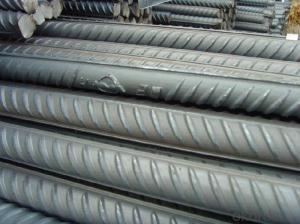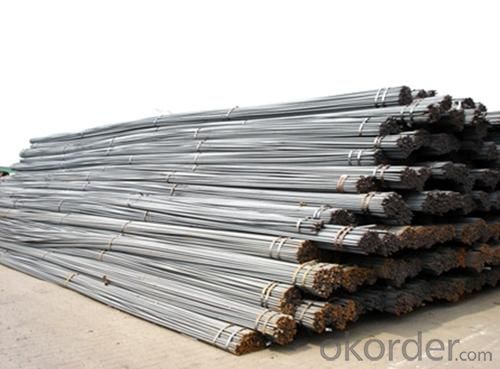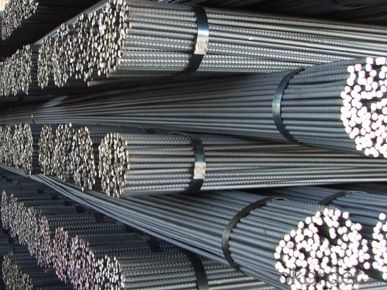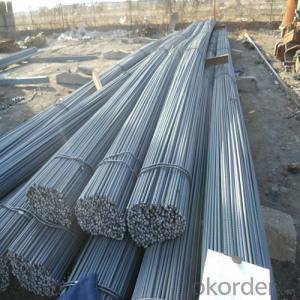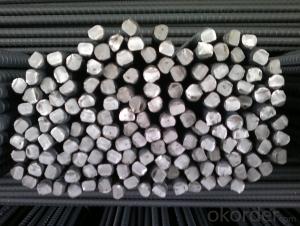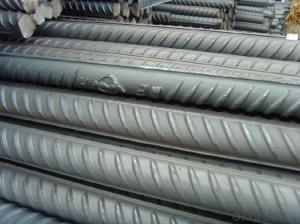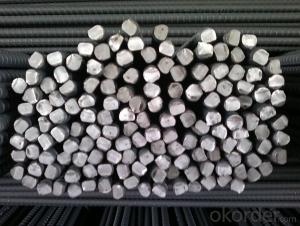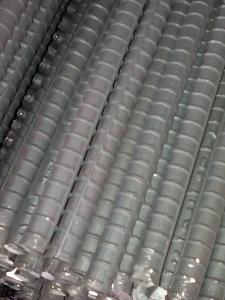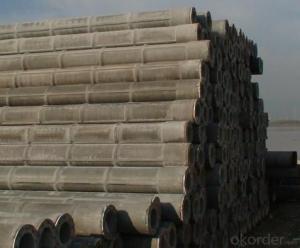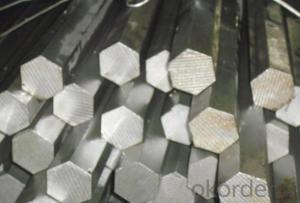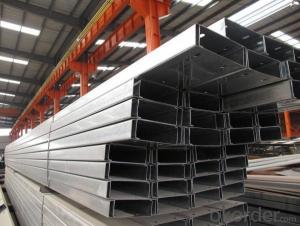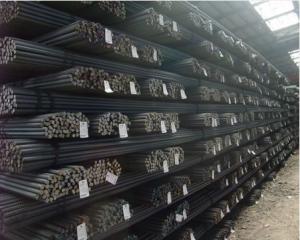Hot Rolled Steel Rebar, Deformed Steel Bar, D-BAR
- Loading Port:
- Tianjin
- Payment Terms:
- TT or LC
- Min Order Qty:
- 25 m.t.
- Supply Capability:
- 35000 m.t./month
OKorder Service Pledge
OKorder Financial Service
You Might Also Like
Product Description:
OKorder is offering Hot Rolled Steel Rebar, Deformed Steel Bar, D-BAR at great prices with worldwide shipping. Our supplier is a world-class manufacturer of steel, with our products utilized the world over. OKorder annually supplies products to European, North American and Asian markets. We provide quotations within 24 hours of receiving an inquiry and guarantee competitive prices.
Product Applications:
Hot Rolled Steel Rebar, Deformed Steel Bar, D-BAR are ideal for structural applications and are widely used in the construction of buildings and bridges, and the manufacturing, petrochemical, and transportation industries.
Product Advantages:
OKorder's Hot Rolled Steel Rebar, Deformed Steel Bar, D-BAR are durable, strong, and resist corrosion.
Main Product Features:
· Premium quality
· Prompt delivery & seaworthy packing (30 days after receiving deposit)
· Corrosion resistance
· Can be recycled and reused
· Mill test certification
· Professional Service
· Competitive pricing
Product Specifications:
Diameter(mm) | Section area (mm²) | Mass(kg/m) | Weight of 12m bar(kg) |
6 | 28.27 | 0.222 | 2.664 |
8 | 50.27 | 0.395 | 4.74 |
10 | 78.54 | 0.617 | 7.404 |
12 | 113.1 | 0.888 | 10.656 |
14 | 153.9 | 1.21 | 14.52 |
16 | 201.1 | 1.58 | 18.96 |
18 | 254.5 | 2.00 | 24 |
20 | 314.2 | 2.47 | 29.64 |
22 | 380.1 | 2.98 | 35.76 |
25 | 490.9 | 3.85 | 46.2 |
28 | 615.8 | 4.83 | 57.96 |
32 | 804.2 | 6.31 | 75.72 |
36 | 1018 | 7.99 | 98.88 |
40 | 1257 | 9.87 | 118.44 |
50 | 1964 | 15.42 | 185.04 |
Packaging & Delivery of Hot Rolled Steel Rebar, Deformed Steel Bar, D-BAR
1. Packing: it is nude packed in bundles by steel wire rod
2. Bundle weight: not more than 3.5MT for bulk vessel; less than 3 MT for container load
3. Marks:
Color marking: There will be color marking on both end of the bundle for the cargo delivered by bulk vessel. That makes it easily to distinguish at the destination port.
Tag mark: there will be tag mark tied up on the bundles. The information usually including supplier logo and name, product name, made in China, shipping marks and other information request by the customer.
If loading by container the marking is not needed, but we will prepare it as customer request.
4. Transportation: the goods are delivered by truck from mill to loading port, the maximum quantity can be loaded is around 40MTs by each truck. If the order quantity cannot reach the full truck loaded, the transportation cost per ton will be little higher than full load.
5. Delivered by container or bulk vessel
FAQ:
Q1: Why buy Materials & Equipment from OKorder.com?
A1: All products offered byOKorder.com are carefully selected from China's most reliable manufacturing enterprises. Through its ISO certifications, OKorder.com adheres to the highest standards and a commitment to supply chain safety and customer satisfaction.
Q2: How do we guarantee the quality of our products?
A2: We have established an advanced quality management system which conducts strict quality tests at every step, from raw materials to the final product. At the same time, we provide extensive follow-up service assurances as required.
Q3: How soon can we receive the product after purchase?
A3: Within three days of placing an order, we will begin production. The specific shipping date is dependent upon international and government factors, but is typically 7 to 10 workdays.
Q4: What makes stainless steel stainless?
A4: Stainless steel must contain at least 10.5 % chromium. It is this element that reacts with the oxygen in the air to form a complex chrome-oxide surface layer that is invisible but strong enough to prevent further oxygen from "staining" (rusting) the surface. Higher levels of chromium and the addition of other alloying elements such as nickel and molybdenum enhance this surface layer and improve the corrosion resistance of the stainless material.
Q5: Can stainless steel rust?
A5: Stainless does not "rust" as you think of regular steel rusting with a red oxide on the surface that flakes off. If you see red rust it is probably due to some iron particles that have contaminated the surface of the stainless steel and it is these iron particles that are rusting. Look at the source of the rusting and see if you can remove it from the surface.
Images:
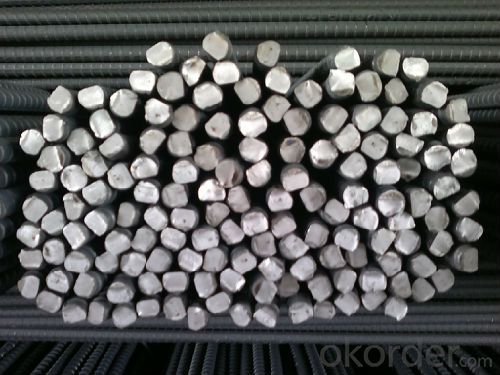
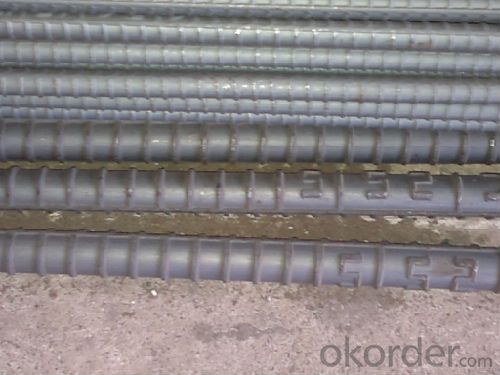
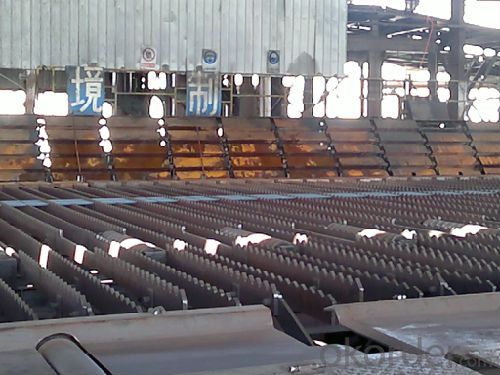
- Q: Are steel rebars suitable for earthquake-resistant structures?
- Yes, steel rebars are suitable for earthquake-resistant structures. Steel rebars provide excellent tensile strength and reinforcement to concrete structures, making them more resistant to the lateral forces and vibrations caused by earthquakes. They help to distribute and absorb the energy generated during seismic events, enhancing the overall structural integrity and reducing the risk of collapse. Steel rebars have been widely used in earthquake-prone areas and are considered a reliable choice for ensuring the safety and stability of buildings and infrastructure during earthquakes.
- Q: How do steel rebars affect the overall crack control of concrete?
- The incorporation of steel rebars into concrete structures is crucial for crack control. Steel rebars significantly improve the otherwise low tensile strength of concrete. Tensile forces, such as drying shrinkage, temperature changes, or applied loads, tend to cause cracks in concrete. However, the presence of steel rebars helps mitigate and control these cracks. Rebars reinforce the concrete and provide additional strength. They resist tensile forces and prevent easy cracking of the concrete. When reinforced concrete is subjected to tensile forces, the rebars bear a significant portion of the load, reducing the stress on the concrete and minimizing crack formation. The bond between the steel rebars and the concrete is essential for crack control. This bond ensures effective transfer of tensile forces to the concrete, enhancing its overall crack resistance. Additionally, the bond helps distribute applied loads evenly, reducing the risk of localized cracking. Steel rebars also have the ability to control crack widths in concrete. By specifying the appropriate diameter, spacing, and arrangement of the rebars, engineers can influence crack widths to meet design requirements. The rebars act as barriers, limiting the width of cracks and maintaining the structural integrity of the concrete. In conclusion, steel rebars have a positive impact on crack control in concrete. They enhance the tensile strength, resist tensile forces, distribute loads, and limit crack widths. Incorporating steel rebars in concrete ensures durability and longevity of structures by effectively controlling crack formation and minimizing their negative consequences.
- Q: How do steel rebars affect the overall lifespan of bridge structures?
- Steel rebars play a crucial role in enhancing the overall lifespan of bridge structures. By reinforcing concrete, rebars increase the tensile strength and structural integrity of the bridge, enabling it to bear heavy loads and withstand various environmental factors such as wind, earthquakes, and temperature fluctuations. This reinforcement prevents cracking, corrosion, and premature failure of the structure, ultimately extending its lifespan and ensuring the safety and reliability of the bridge for an extended period of time.
- Q: What is the effect of high temperatures on steel rebars?
- Steel rebars are significantly affected by high temperatures. When exposed to high temperatures, steel rebars undergo thermal expansion, causing them to increase in size. This expansion can cause cracks or spalling in the surrounding concrete as the larger rebars exert pressure on it. Moreover, high temperatures can weaken and reduce the load-bearing capacity of steel rebars. This weakening phenomenon, known as tempering, occurs when heat compromises the structural integrity of the steel, making it less strong. Consequently, steel rebars exposed to high temperatures may experience reduced strength and become more prone to deformation or failure. Therefore, when designing structures or assessing their integrity, it is crucial to consider the impact of high temperatures on steel rebars, particularly in environments susceptible to heat or fire hazards.
- Q: How do steel rebars contribute to the overall fire resistance of a structure?
- Steel rebars contribute to the overall fire resistance of a structure by providing strength and stability. When exposed to high temperatures during a fire, steel rebars do not combust or lose their structural integrity easily. Instead, they retain their load-bearing capacity, preventing the collapse of the structure. Additionally, the thermal conductivity of steel helps in dissipating heat, reducing the spread and intensity of the fire within the building.
- Q: What is the process of handling and transporting steel rebars on-site?
- The process of handling and transporting steel rebars on-site involves several steps to ensure their safe and efficient movement. 1. Receiving: The first step is the receipt of the steel rebars at the construction site. This typically involves unloading the rebars from the delivery truck and inspecting them for any damage or defects. 2. Storage: Once unloaded, the rebars are typically stored in a designated area, known as a rebar yard. The rebars are arranged and stacked in a way that allows for easy access and prevents them from getting damaged or tangled. 3. Cutting and bending: Depending on the specific requirements of the construction project, the rebars may need to be cut or bent to a certain shape before installation. This process is typically done using specialized tools and equipment, such as rebar cutters and benders. 4. Transportation to the work area: Once the rebars are cut and bent, they need to be transported to the specific area on the construction site where they will be installed. This can be done manually by workers carrying individual rebars or by using mechanical equipment, such as cranes or forklifts, to move larger quantities of rebars at once. 5. Installation: Once the rebars have been transported to the work area, they are installed according to the project's design and specifications. This usually involves placing the rebars into the appropriate position within the concrete structure, such as columns, beams, or slabs. Throughout the entire process, it is crucial to follow safety guidelines to prevent accidents or injuries. This includes wearing appropriate protective gear, such as gloves and safety boots, and ensuring that the rebars are handled and transported in a way that minimizes the risk of tripping or falling. Additionally, regular inspections should be conducted to check for any damage or defects in the rebars, as these can compromise the structural integrity of the construction project.
- Q: Can steel rebars be used in structures with high levels of carbonation or acid attack?
- No, steel rebars should not be used in structures with high levels of carbonation or acid attack. Steel is susceptible to corrosion in acidic environments, and high carbonation levels can increase the acidity of the surroundings. In such conditions, alternative materials that are resistant to corrosion and acid attack, such as stainless steel or fiber-reinforced polymers, should be considered for structural reinforcement.
- Q: How do steel rebars affect the overall vibration control of a structure?
- Steel rebars can significantly enhance the overall vibration control of a structure. By reinforcing the concrete, rebars increase the structural stiffness and strength, reducing the amplitude of vibrations. They also help distribute and dissipate energy from dynamic loads, thus minimizing the risk of structural failure and enhancing the overall stability. Additionally, rebars can improve the damping characteristics of a structure, reducing the resonant frequencies and attenuating vibrations. Overall, the presence of steel rebars in a structure plays a crucial role in enhancing its vibration control capabilities.
- Q: How do steel rebars contribute to the strength of concrete structures?
- Steel rebars contribute to the strength of concrete structures in several ways. Firstly, they enhance the tensile strength of the concrete. While concrete is strong in compression, it is weak in tension. When tensile forces act on a concrete structure, such as when it is subjected to bending or stretching, the steel rebars bear the load and prevent the concrete from cracking or failing. Secondly, steel rebars help to control and prevent the propagation of cracks in concrete. By being embedded within the concrete, rebars provide a reinforcing framework that redistributes the stress throughout the structure. This helps to limit the formation and expansion of cracks, ensuring the overall integrity and durability of the concrete structure. Furthermore, steel rebars improve the overall structural stability and load-bearing capacity of concrete structures. By distributing the load more evenly, the presence of rebars allows concrete structures to withstand greater external forces, such as the weight of a building or the impact of seismic activity. In addition to their strength-enhancing properties, steel rebars also improve the longevity of concrete structures. The steel used in rebars is highly resistant to corrosion, which is a common issue in concrete structures exposed to harsh environmental conditions or corrosive elements. This resistance to corrosion ensures that the rebars maintain their strength and structural integrity over time, extending the lifespan of the concrete structure. In summary, steel rebars contribute significantly to the strength of concrete structures by enhancing the tensile strength, controlling crack propagation, improving structural stability, and increasing longevity. Their presence ensures that the concrete can withstand various external forces and maintain its structural integrity, making them an essential component in the construction of durable and reliable concrete structures.
- Q: How do steel rebars affect the overall load-bearing capacity of a structure?
- Steel rebars greatly enhance the load-bearing capacity of a structure. These reinforcing bars are typically added to concrete structures, such as beams, columns, and slabs, to provide additional strength and durability. The primary function of rebars is to resist tensile forces, which concrete alone is not capable of doing effectively. By embedding steel rebars within the concrete, the overall load-bearing capacity of the structure increases significantly. When a load is applied to the structure, the rebars distribute the forces more evenly, preventing cracks and minimizing the risk of structural failure. This reinforcement increases the structure's ability to withstand heavy loads, including the weight of the building itself, live loads like furniture and occupants, and external forces such as wind and earthquakes. The rebars also help to control and limit the propagation of cracks within the concrete. Concrete is strong in compression but weak in tension, so without the presence of rebars, it would be prone to cracking under tensile stress. The rebars act as a reinforcement by absorbing some of the tensile forces, preventing the cracks from expanding and compromising the structure's overall strength. Moreover, steel rebars improve the ductility of the structure. Ductility refers to the ability of a material to deform without fracturing. When a structure experiences excessive loads or undergoes deformation due to external factors, the rebars help in absorbing and dissipating the energy, allowing the structure to deform in a controlled manner rather than abruptly collapsing. In summary, steel rebars significantly enhance the load-bearing capacity of a structure by providing tensile strength, preventing the propagation of cracks, and improving ductility. By reinforcing the concrete, rebars ensure the structure can withstand heavy loads, increasing its strength, durability, and overall safety.
Send your message to us
Hot Rolled Steel Rebar, Deformed Steel Bar, D-BAR
- Loading Port:
- Tianjin
- Payment Terms:
- TT or LC
- Min Order Qty:
- 25 m.t.
- Supply Capability:
- 35000 m.t./month
OKorder Service Pledge
OKorder Financial Service
Similar products
Hot products
Hot Searches
Related keywords
